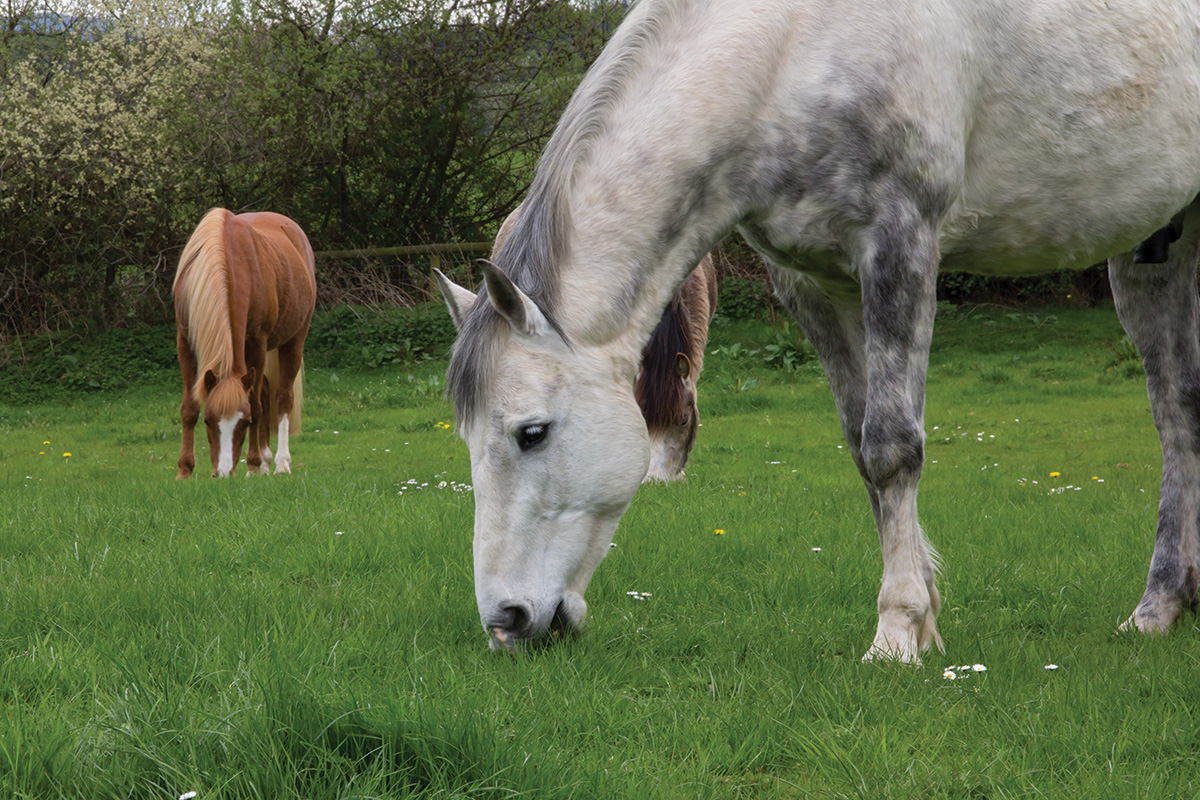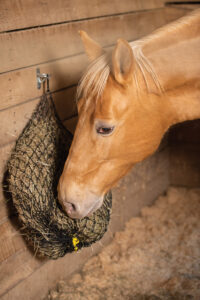
We all love to see our horse enjoying a graze on delicious spring grass. But that pasture your horse eats with such gusto is not as benign as you might think—particularly for horses with metabolic disorders or genetic predispositions, although any horse of any breed can develop grass-related hoof issues at any time. In fact, some horses are better off avoiding the green stuff altogether. Learn how to manage your pasture and feed program to prevent founder or laminitis in your horse.
Mineral Balance
Other vital minerals like zinc, copper, and manganese may also be present, but their levels in relationship to one another will affect how available they are to your horse. Minerals compete for absorption sites along your horse’s intestinal walls.
For example, if zinc levels are too high, they can block copper, a mineral that’s essential for maintaining the robust lamellar tissue your horse needs for his coffin bone to be properly supported within the hoof capsule. Iron is another competitive mineral that inhibits uptake of other minerals that are prevalent in grass.
Starch and Sugar Levels
Sugars and starches can be present in pasture grasses in levels that trigger a laminitic event. These nutrients are meant to be digested in the small intestine, but if your horse ingests these simple carbs in quantities greater than the small intestine can handle, the excess will continue along the digestive tract into the large intestine.
The large intestine is populated with microbes that process digestible fiber. These beneficial microbes thrive in an environment with a relatively neutral pH. If they are overrun with

sugar and starch, their home becomes so acidic they can’t survive. When they die, they release substances that are toxic to your horse.
At the same time, acid-loving microbes take over and compromise the integrity of the intestinal wall, allowing those toxins to penetrate and enter your horse’s bloodstream. When they reach the hooves, they cause the blood vessels to constrict, starving your horse’s hooves of nutrients and setting off a laminitic event.
Forage with a simple sugar (technically known as ethanol-soluble carbohydrates, or ESC) plus starch level of 10 percent or less should be low enough to keep your horse’s microbial population happy. If the levels in the grass are higher and your horse shows signs of inflammation, you will need to limit or restrict your horse’s access to pasture (find grazing muzzle options here).
Some signs that your horse may be getting too much starch and sugar from pasture include a thick, cresty neck; tender feet; a distended or more intense digital artery pulse (on your horse’s ankle); flared or ridged hoof walls; and unusual weight gain or loss.
Instead of grazing, provide low sugar/starch hay 24/7 in a slow feeder, such as a hay net with small holes or another device. To learn what the sugar and starch levels in your pasture are, have it analyzed by an agricultural lab. The report will give you the information you need to determine if your pasture is safe. If you aren’t sure how to interpret the results, an equine nutritionist can decipher the data and help you balance your horse’s diet accordingly.
Mycotoxins
If your hay’s starch and sugar levels are low and your horse’s diet is balanced, but the grass is still triggering laminitis, mycotoxins could be to blame. Mycotoxins are naturally occurring toxic compounds released by fungi that live in grass. Mycotoxins are vasoconstrictors that are absorbed quickly through the small intestine and trigger a systemic inflammatory response, which can then cause laminitis.
According to Jennifer Duringer, Ph.D., director of Oregon State University’s Endophyte Lab, there are more than 500 known mycotoxins.
“Mycotoxin levels rise and fall seasonally and are present in more grass species than was once believed,” she says. “We are currently conducting a study to identify which species are infected.”
You can combat mycotoxins by turning your horse out on a dry lot instead of a pasture, although mycotoxins can be and often are present in cured hay. If you suspect your horse is suffering from mycotoxin-induced laminitis, try removing the offending toxins with a mycotoxin binder to reduce inflammation. These can be found in certain equine feed supplements that generally contain yeast derivatives.
Keeping a laminitis or founder-prone horse on pasture can be challenging, if not impossible. Keep up the good fight against pain and discomfort by reducing grazing as needed, testing hay, and being aware of potential mycotoxins.
This article about how to feed to prevent founder appeared in the March 2022 issue of Horse Illustrated magazine. Click here to subscribe!





